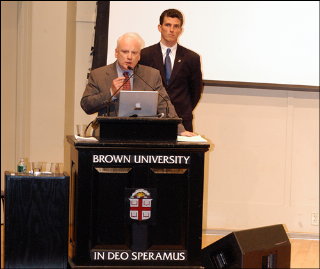

LBREPORT.COM CONGRATULATES FRIENDS OF LB ANIMALS, A LB HONOREE IN "MAKE A DIFFERENCE DAY"
Become A Hero To LB Animals With A $15 Membership. Learn About Us, Click Here.

Saving Lives Thru Spay/Neuter & Education





3853 Atlantic Ave.
|
Click here |
Rhode Island Atty Gen'l Releases Report on "LNG Facilities in Urban Areas: Security Risk Mgt. Analysis." Principal Investigator: (May 17, 2005) -- The Rhode Island Attorney General's office has released a detailed, at times chilling, 150+ page report entitled "LNG Facilities in Urban Areas: A Security Risk Management Analysis."
The report's principal investigator was Richard A. Clarke, former National Security Council In a written release, Rhode Island Attorney General Patrick Lynch said:
"This is the kind of information that the big-money LNG industry hasn’t wanted the public to have since they started putting all of these terminal proposals on the drawing board. I hope that Richard Clarke’s threat analysis helps inform the public, both here in Southeastern New England and nationally, about the stupidity and short-sightedness of siting LNG facilities in densely populated urban areas."
Clarke presented the report to RI Attorney General Lynch on May 9 at Brown University. The report states in part:
"If all alternative sites do cost more and governments do proceed with the proposed urban location because of that cost differential, then the cost trade-off can be precisely measured. Governments would be deciding that avoiding the possible additional financial cost to the LNG operator and/or consumers of a more secure location is more important public policy than avoiding the additional risk of a catastrophic attack involving mass trauma and burn injuries which does accompany a decision to permit an urban LNG facility." LBReport.com posts a link to the complete LNG Security Risk Management Assessment on the Rhode Island Attorney General's website, below.
Among the Report's key judgments:
...SECURITY RISK MANAGEMENT: An appropriate security risk management methodology examines five factors:
...CAPABILITY: ...Weapons and other capabilities needed to conduct an attack
on an urban LNG off loading facility or an LNG tanker can be readily obtained in the US, according to US Government reports. A variety of boats and scuba gear can be easily
procured. General Aviation aircraft can easily be rented or stolen at numerous small airports throughout the US.
Explosives are readily available, both fertilizer based
weapons, which can be procured without a license, and
commercial explosives, which are frequently stolen and sold
on the black market. Fifty caliber rifles with anti-armor
shells are readily available in the US. Rocket propelled
grenades (RPGs), light anti-tank weapons, mortars, and
bazooka styled weapons are very easily and cheaply
obtainable on the international gray arms market. Few
containers entering the United States are inspected by US
Customs.
...VULNERABILITIES: Both the proposed urban LNG off loading
facility and the proposed LNG tanker transit through 29
miles of Rhode Island have security vulnerabilities that are
unlikely to be successfully remediated.
The creation of permanent or temporary restricted flight
areas around the urban LNG facility and the tanker will not
prevent hijacked or stolen aircraft (commercial passenger,
commercial freight, or general aviation) from successfully
penetrating the restricted airspace and crashing into the
facility and/or ship. No air defense system is planned, nor
is it easy to imagine a system which would authorize the use
of deadly force against an aircraft that might appear to
have unintentionally strayed into the restricted air space.
As to the LNG ship, the creation of restricted waterways
around the LNG tanker and the use of armed Coast Guard
(USCG) patrol craft provides little assurance that a
determined terrorist group would be stopped before attacking
the tanker with an explosives laden vessel. Narraganset Bay
is home to thousands of small craft. The USCG and other law
enforcement agencies would be reluctant to use lethal force
against an apparently misguided pleasure craft. Moreover,
the escorting patrol boats could themselves be attacked in a
multi-boat terrorist operation. Counter-SCUBA operations in
the Bay would also not offer high assurance of success.
Attacks involving stand off weapons could be mounted from
boats or from numerous land locations along the route. To
prevent the entry of weapons for land based, stand-off
attacks, all vehicles entering the littoral would have to be
searched not just during the tanker’s transit, but at all
times.
As to the urban LNG facility, it currently appears to have
inadequate security to prevent unauthorized penetration.
Upgrades to the facility would be unlikely to prevent the
two wave attack technique demonstrated by al Qaeda in Saudi
Arabia, Iraq, Kenya, Pakistan and elsewhere. The two wave
attack involves an initial explosion or small arms attack
directed at security gates and guards, followed by a second
attacking vehicle carrying a large explosive.
We are unaware of any analysis performed by counterterrorism
experts in the US Government, such as the US
Special Operation Command, that would demonstrate the
ability of the Coast Guard and the Rhode Island police to
prevent attacks by determined and skilled terrorists on
either the urban off loading facility and/or the LNG tanker
during its 29 mile inland waterway transit.
...CONSEQUENCES: There is a spectrum of expert opinion on
the precise extent of damage that would result from various
levels of attack on an urban LNG facility and on an LNG
tanker. There appears, however, to be a high risk that
catastrophic damage could occur if a large breach were made
in the urban LNG facility’s tank, if three of five
containers aboard the LNG tanker were breached, or if an
attack occurred involving both the facility and the tanker
during unloading.
The consequences of a major attack could include fires that
would damage homes, hospitals, a chemical plant, and other
infrastructure, depending upon where the attack occurred.
Many fires could exceed the 2000 BTU limit for the
employment of fire fighters, necessitating a “let it burn”
approach to many structures. There would be both prompt and
delayed fatalities.
The delayed fatalities and the wounded could place a burden
on the Rhode Island and South Eastern Massachusetts trauma,
burn, and overall emergency medical response capability that
the system would be unable to handle. It is unclear where
the funding would come from to upgrade the region’s
consequence management capabilities to be able to deal with
a possible catastrophic attack on the urban LNG facility
and/or tanker. Governments could, however, place that
burden on the facility owners and operators, similar to the
Nuclear Regulatory Commission’s approach to commercial
nuclear reactors.
...RECOVERY: The financial cost of compensating victims
and rebuilding damaged or destroyed facilities following a
catastrophic attack on the urban LNG facility and/or LNG
tanker would likely exceed any insurance carried by the
owners and operators of the LNG facility and tanker.
...HIDDEN COSTS: In the absence of adequate insurance to
pay victims and rebuild damaged or destroyed facilities, the
LNG operators would be transferring the financial cost of
the risk they would be creating either to the victims or to
governments, or to some combination of both. Governments
would also bear costs for greatly enhanced security and
consequence management, including mass trauma and burn
capabilities.
...RISK JUDGMENT: We judge that terrorist groups now have
the intent to attack facilities in the US such as the urban
LNG off loading facility proposed. We judge that they could
relatively easily both obtain the needed capability and
conduct an attack on the urban LNG facility and/or the LNG
tanker during its transit of 29 miles of inland waterway.
We judge that such attacks run a high risk of generating
catastrophic damage, with which the region could not
adequately cope during the consequence management or
recovery phases.
...RISK REDUCTION AND AVOIDANCE: We doubt that deterrence
or prevention measures could be designed and implemented for
the proposed facility and ship routing that would be
adequate against a determined and skilled terrorist group of
the type that exists today. Possibilities for further
investigation, however, include:
Alternatively, the LNG off loading facility could be sighted
in a location that did not involve either an urban
environment for the facility or an inland waterway transit
for the LNG tanker. Locating the facility in a non-urban
environment and eliminating the inland waterway transit
would significantly reduce both the attractiveness to
terrorists of an attack (because the attack would not
generate large scale casualties) and the consequence
management and recovery burdens on governments should an
attack occur. We note that GAO, the investigatory arm of
the Congress, recommended in 1979 that the Congress or
Administration prohibit any additional large scale LNG
facilities in or LNG tanker transit through urban areas.
NET ASSESSMENT: While there is no adequate way in which to
determine the probability of a terrorist attack on the
proposed urban LNG facility and inland waterway transit
routing, there is adequate grounds to judge that such an
attack would be consistent with terrorists demonstrated
intent and capability. There is also a basis to judge that
likely enhanced security measures would not significantly
reduce the risk. While there are some differences among
experts about the conditions needed to generate a
catastrophic explosion and about the precise extent of the
resulting damage, there is significant grounds to conclude
that a high risk exists of catastrophic damage from the
types of attacks terrorists are capable of mounting. Those
damage levels would overwhelm regional trauma, burn, and
emergency medical capabilities. The LNG facility’s insurance
is likely to be inadequate to fully compensate victims and
to rebuild facilities.
Siting the LNG off loading facility in a non-urban setting
would reduce the terrorists’ incentives to attack it.
Non-urban locations may possibly increase costs to the LNG
operator and consumers.
If all alternative sites do cost more and governments decide
to proceed with the proposed urban location because of that
cost differential, then the cost trade off can be precisely
measured. Governments would be deciding that avoiding the
possible additional financial cost to the LNG operator
and/or consumers of a more secure location is more important
public policy than avoiding the additional risk of a
catastrophic attack involving mass trauma and burn injuries
which does accompany a decision to permit an urban LNG
facility. LB currently faces a proposal by a Mitsubishi subsidiary, Sound Energy Solutions, which seeks to build and operate an 80+ million gallon LNG facility in the Port of LB, roughly two miles from downtown LB.
While RI state and local officials have fought LNG proposals potentially impacting them, the LB City Council and the Port of LB have both entered into separate Memoranda of Understanding with the firm in 2003. (The Council acted in 87 seconds.) The MOU's didn't grant permit authority or commit to approval (the Council MOU foresaw reduced natural gas costs for LB's City Hall-run gas utility if the project were completed) but no LB public official has since publicly opposed the LNG proposal.
In June 2003, LB Mayor Beverly O'Neill wrote U.S. Senator Dianne Feinstein (D., CA), asking her to help speed the project. After LBReport.com published the letter, Mayor O'Neill acknowledged to rankled Councilmembers that the Council, not the Mayor, makes city policy...but since then, the Council has not taken a policy position on the LNG proposal...and the Mayor has not backed away from her individual support for the project (evident in her correspondence to Sen. Feinstein).
Under the current LB City Charter, a Mayor-chosen, Council-approved "Board of Harbor Commissioners" will decide whether the project proceeds (as landlord over Port property.) Other state and local agencies must also grant approval within their jurisdictions, although this may be reduced to some extent by advancing federal energy legislation (see below).
Since 2003, the Port of LB has allowed the application process to proceed without the applicant seeking approval from CA's Public Utilities Commission (CPUC). CPUC says its approval is required by CA law...but the Port assisted the applicant in working with the Federal Energy Regulatory Commission (FERC), which then issued a decision announcing that it has exclusive authority in siting and regulatory decisionmaking...and said CPUC has none.
The Port's actions spawned a national test case in which CPUC sued FERC to enforce CA law. That in turn prompted federal LNG legislation now contained in an advancing national Energy bill that would give FERC unambiguous supremacy in regulating and siting LNG plants.
In addition, the advancing federal legislation would effectively undercut CA and LB authority on environmental review (EIR/EIS) and safety regulation. LB City Hall, which did not object while the Port effectively accepted federal LNG supremacy for two years, now says it opposes the advancing federal LNG provisions.
The House passed the bill in April; action in the Senate is forthcoming. The LB City Council currently relies on the same firm that provides Washington, D.C. legislative services (advocacy/monitoring) for the Port of LB to provide legislative advocacy services to LB City Hall via a separate, six figure contract.
In late April 2005, LBPD officials told a meeting of the Council's Federal Legislation & Environmental Affairs Committee (chair Colonna, members Kell & In June 2004, a LB delegation including Harbor Commissioners James C. Hankla and Mario Cordero, Port of LB Managing Director Geraldine Knatz, Ph.D. and 7th district Councilwoman Tonia The Port's 2004 trip included a meeting with the LNG facility operator and U.S. Coast Guard Boston officialdom...but according to Councilwoman The Port group did not meet with Boston Mayor Thomas Menino -- a former president of the U.S. Conference of Mayors (a post to which LB Mayor O'Neill is slated to ascend in June) -- who has urged that the Boston area LNG facility be closed.
The Port's conduct on LNG and other matters became an issue during an April 2005 City Council study session on LNG...when a member of the public [we've since learned, a 1st district resident] publicly called for making LB Harbor Commissioners an elective position. Her comments drew applause.
To access the full report released by Rhode Island's Attorney General, click "LNG Facilities in Urban Areas: A Security Risk Management Analysis" (pdf, 3.4 MB).
Contact us: mail@LBReport.com |
